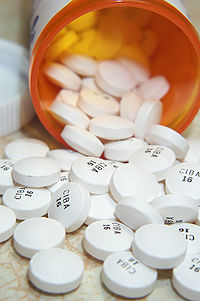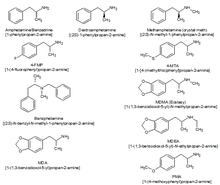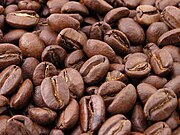Stimulants (also referred to as psychostimulants) are psychoactive drugs which induce temporary improvements in either mental or physical functions or both. Examples of these kinds of effects may include enhanced alertness, wakefulness, and locomotion, among others. Due to their effects typically having an "up" quality to them, stimulants are also occasionally referred to as "uppers". Depressants or "downers", which decrease mental and/or physical function, are in stark contrast to stimulants and are considered to be their functional opposites. Stimulants are widely used throughout the world as prescription medicines and as illicit substances of recreational use or abuse.
Effects[edit]
Stimulants produce a variety of different kinds of effects by enhancing the activity of the central and peripheral nervous systems. Common effects, which vary depending on the substance in question, may include enhanced alertness, awareness, wakefulness, endurance, productivity, and motivation, increased arousal, locomotion, heart rate, and blood pressure, and the perception of a diminished requirement for food and sleep. Many stimulants are also capable of improving mood and relieving anxiety, and some can even induce feelings of euphoria. However, many of these drugs are also capable of causing anxiety and heart failure, even the ones that may paradoxically reduce it to a degree at the same time. Stimulants exert their effects through a number of different pharmacological mechanisms, the most prominent of which include facilitation of norepinephrine (noradrenaline) and/or dopamine activity (e.g., via monoamine transporter inhibition or reversal[1]), adenosine receptor antagonism, and nicotinic acetylcholine receptor agonism.
Medical uses[edit]
Stimulants are used both individually and clinically for therapeutic purposes in the treatment of a number of indications, including the following:
- To counteract lethargy and fatigue throughout the day while at work or while doing other activities.
- To reduce sleepiness and to keep the person awake when necessary, as well as to treat narcolepsy.
- To decrease appetite and promote weight loss, as well as to treat obesity.
- To improve concentration and focus while at work or school, especially for those with attentional disorders such as ADHD.
- Occasionally, they are also used off label to treat clinical depression, more particularly, non-typical depression and treatment-resistant depression.
Types[edit]
Ampakines[edit]
Main article: Ampakine
Recently, there have been improvements in the area of stimulant pharmacology, producing a class of chemicals known as ampakines, or eugeroics, (good arousal). These stimulants tend to increase alertness without the peripheral (body) effects or addiction/tolerance/abuse potential of the traditional stimulants. They have minimal effect on sleep structure, and do not cause rebound hypersomnolence or "come down" effects. Ampakines such as ampalex and CX717 have been developed but are still in clinical trials and have not yet been sold commercially. Another compound with similar effects to these drugs is carphedon, which is sold as a general stimulant in Russia under the brand name Phenotropil.
[edit]
Main article: Amphetamine
Amphetamines are a group of phenylethylamine stimulants such as amphetamine and methamphetamine. Like NDRIs, amphetamine increases the levels of norepinephrine and dopamine in the brain via reuptake inhibition; however, the more important mechanism by which amphetamines cause stimulation is through the direct release of these catecholamines from storage vesicles in cells. Amphetamines are known to cause elevated mood and euphoria as well as rebound depression and anxiety.[2]
Amphetamines are often used for their therapeutic effects; physicians occasionally prescribe amphetamines to treat major depression, where subjects do not respond well to traditional SSRI medications, and numerous studies have demonstrated the effectiveness of drugs such as Adderall in controlling symptoms associated with ADD/ADHD. Due to their availability and fast-acting effects, amphetamines are prime candidates for abuse.[3]
Catha edulis (Khat)[edit]
Main article: Khat
Khat contains a monoamine alkaloid called cathinone, an amphetamine-like stimulant, which is said to cause excitement, loss of appetite and euphoria. In 1980, the World Health Organization (WHO) classified it as a drug of abuse that can produce mild to moderatepsychological dependence (less than tobacco or alcohol),[6] although the WHO does not consider khat to be seriously addictive.[5] It is a controlled substance in some countries, such as the United States, Canada and Germany, while its production, sale and consumption are legal in other nations, including Djibouti, Ethiopia, Somalia and Yemen.[7]
Cathine[edit]
Main article: Cathine
Cathinone[edit]
Main article: Cathinone
Bupropion[edit]
Main article: Bupropion
Bupropion (/bjuːˈproʊpi.ɒn/ bew-proh-pee-on[8]) is a drug marketed as Wellbutrin, Budeprion, Prexaton, Elontril, Aplenzin, or other trade names. It is one of the most frequently prescribed antidepressants in the United States. Marketed in lower-dose formulations as Zyban, Voxra, or other names, it is also widely used as a smoking cessation aid. It is taken in the form of pills, and in the United States is available only by prescription.
Medically, bupropion serves as a non-tricyclic antidepressant fundamentally different from most commonly prescribed antidepressants such as selective serotonin reuptake inhibitors (SSRIs). It is an effective antidepressant on its own, but is also popular as an add-on medication in cases of incomplete response to first-line SSRI antidepressants. In contrast to many other antidepressants, it does not cause weight gain or sexual dysfunction. The most important side effect is an increase in risk for epileptic seizures, which lead to the recommended dosage to be reduced. 300mg a day (for average body weight) has been shown to maintain the same 0.1% unprovoked seizure rate of the general population.
Bupropion affects a number of neurotransmitter systems, and its mechanisms of action are only partly understood. The primary pharmacological action of the drug is as a milddopamine reuptake inhibitor and also a much weaker norepinephrine reuptake inhibitor as well as a nicotinic acetylcholine receptor antagonist. Chemically, bupropion belongs to theclass of aminoketones and is similar in structure to stimulants such as cathinone and amfepramone, and to phenethylamines in general.
Bupropion is patented by GlaxoSmithKline. It was originally called amfebutamone, before being renamed in 2000.[9] Its chemical name is 3-chloro-N-tert-butyl-β-ketoamphetamine. It is a substituted cathinone (β-ketoamphetamine), as well as a substituted amphetamine.
Dextroamphetamine ("Dexedrine", contained in "Adderall")[edit]
Main article: Dextroamphetamine
Dextromethamphetamine ("Desoxyephedrine", contained in "Desoxyn")[edit]
Main article: Dextromethamphetamine
Ephedrine[edit]
Main article: Ephedrine
Ephedrine is a sympathomimetic amine similar in molecular structure to the well-known drugs phenylpropanolamine and methamphetamine, as well as to the importantneurotransmitter epinephrine (adrenalin). Ephedrine is commonly used as a stimulant, appetite suppressant, concentration aid, decongestant, and to treat hypotension associated with anaesthesia.
Chemically, it is an alkaloid with a phenethylamine skeleton found in various plants in the genus Ephedra (family Ephedraceae). It works mainly by increasing the activity ofnorepinephrine (noradrenalin) on adrenergic receptors.[10] It is most usually marketed as the hydrochloride or sulfate salt.
The herb má huáng (麻黄, Ephedra sinica), used in traditional Chinese medicine (TCM), contains ephedrine and pseudoephedrine as its principal active constituents. The same may be true of other herbal products containing extracts from other Ephedra species.
L-Norpseudoephedrine[edit]
Main article: L-Norpseudoephedrine
Levoamphetamine (contained in "Adderall")[edit]
Main article: Levoamphetamine
Levoamphetamine (also levamfetamine, (R)-amphetamine or (−)-amphethamine) is a psychostimulant known to increase wakefulness and focus in association with decreasedappetite and fatigue. Levoamphetamine is the levorotatory stereoisomer of the amphetamine molecule. It possesses much weaker dopaminergic activity than the dextrorotary isomer (dextroamphetamine) and acts as a selective releasing agent of norepinephrine, similarly to levomethamphetamine. The amphetamine racemate contains two stereoisomers, dextroamphetamine and levoamphetamine, both exhibiting amphetaminergic (amphetamine-like) effects.
Among the formulations for Levoamphetamine is Adderall and Benzedrine.
Levomethamphetamine (contained in Vicks Vapor Inhaler)[edit]
Main article: Levomethamphetamine
Lisdexamfetamine ("Vyvanse")[edit]
Main article: Lisdexamfetamine
MDA[edit]
Main article: 3,4-Methylenedioxyamphetamine
MDA differs from most stimulants in that its primary pharmacological effect is on the neurotransmitter serotonin rather than dopamine, epinephrine, or norepinephrine. Because of this, it is considered to be primarily an entactogen or an empathogen.
MDMA[edit]
Main article: MDMA
Methylenedioxymethamphetamine (MDMA), known by its common street name "Ecstasy", typically comes in either tablet, capsule, or powder/crystal form. It had a medical application as a treatment for depression and a psychotherapy aid until 1985 when the DEA listed MDMA as a Schedule I controlled substance, prohibiting most medical studies and applications. Notably, MDMA is also unique and very popular for its entactogenic properties. The stimulant effects of MDMA include hypertension, anorexia (appetite loss), euphoria, social disinhibition, insomnia (or enhanced wakefulness), improved energy, increased arousal, and increased perspiration, among others.
MDMA differs from most stimulants in that its primary pharmacological effect is on the neurotransmitter serotonin rather than dopamine,epinephrine, or norepinephrine. Because of this, it is considered to be primarily an entactogen or an empathogen.
Mephedrone[edit]
Main article: Mephedrone
Methamphetamines[edit]
Main article: Methamphetamine
Dextromethamphetamine and levomethamphetamine (see earlier sections) are the two enantiomers of methamphetamine, and are separate medications indicated for different uses. Unless otherwise specified "methamphetamine" refers to a racemic mixture (50%/50%) of the two.
Norephedrine[edit]
Main article: Norephedrine
Norpseudoephedrine[edit]
Main article: Norpseudoephedrine
Pemoline[edit]
Main article: Pemoline
Pentorex[edit]
Main article: Pentorex
Phentermine[edit]
Main article: Phentermine
Pseudoephedrine[edit]
Main article: Pseudoephedrine
Dopamine precursors[edit]
Unlike amphetamines, and other substances which are dopamine agonists, which either stimulate the release or inhibit the reuptake of dopamine or norepinephrine (which itself is synthesized from dopamine, typically with the help of the amino acid SAM-e, also available as a supplement), dopamine precursors are used by the body in the manufacturing of dopamine.
L-Dopa[edit]
Main article: L-DOPA
L-Dopa can cross the blood-brain barrier, and can be converted by the body into dopamine.
L-Tyrosine[edit]
See also: Tyrosine
L-Tyrosine is the precursor that is 'closest' to being dopamine among those supplements legally available without prescription in most jurisdictions. It cannot cross the blood-brain barrier, but is converted by the body into L-Dopa, which can. Tyrosine must be taken on an empty stomach and the dosages recommended by most supplement companies may not be sufficient for a noticeable effect.
Phenylalanine[edit]
Main article: Phenylalanine
Phenylalanine is 'one step back' from L-Tyrosine--it must be converted into Tyrosine before the Tyrosine can be converted into L-Dopa, which in turn becomes dopamine.
Eugeroics[edit]
Main article: Eugeroics
Adrafinil[edit]
Main article: Adrafinil
Adrafinil is the prodrug of Modafinil, and is metabolized into it in about one hour, when taken on an empty stomach.
Armodafinil[edit]
Main article: Armodafinil
Armodafinil is an enantiopure (non-racemic) version of Modafinil with similar psychoactive properties.
CRL-40,941[edit]
Main article: CRL-40,941
JZ-IV-10[edit]
Main article: JZ-IV-10
JZ-IV-10 is also an SNDRI.
Modafinil[edit]
Main article: Modafinil
Modafinil (Provigil/Alertec/Modavigil) is an analeptic drug approved by the (FDA) for the treatment of narcolepsy, shift work sleep disorder, and excessive daytime sleepiness associated with obstructive sleep apnea.
Modafinil, like other stimulants, increases the release of monoamines but also elevates hypothalamic histamine levels, leading some researchers to consider Modafinil a "wakefulness promoting agent" rather than a classic amphetamine-like stimulant.
Modafinil has been shown to be effective in the treatment of Attention-Deficit Hyperactivity Disorder (ADHD), depression, cocaine addiction, Parkinson's Disease, schizophrenia, shift workers' sleep disorder and disease-related fatigue.
Fencamfamine[edit]
Main article: Fencamfamine
H3 antagonists[edit]
Main article: H3_antagonist
Methylhexanamine (DMAA)[edit]
Main article: Methylhexanamine
NDRAs[edit]
Fenozolone[edit]
Main article: Fenozolone
Nicotine[edit]
Main article: Nicotine
Nicotine is the active chemical constituent in tobacco, which is available in many forms, including cigarettes, cigars, chewing tobacco, and smoking cessation aids such asnicotine patches, nicotine gum and electronic cigarettes. Nicotine is used widely throughout the world for its stimulating, and relaxing effects.
NRIs, NDRIs, and SNDRIs[edit]
Main article: Norepinephrine reuptake inhibitor
Main article: Norepinephrine-dopamine reuptake inhibitor
These drugs inhibit the reuptake of norepinephrine and/or dopamine, resulting in increased extracellular levels and therefore enhanced neurotransmission, ultimately producing a stimulant effect. Many of these compounds are used as ADHD medications and antidepressants. The two best-known NRIs are atomoxetine (Strattera) and reboxetine (Edronax). Many of these drugs have a considerably lower abuse potential in comparison to other stimulants like the amphetamines and cocaine. Reboxetine has been withdrawn from the market in the USA due to unproven efficacy and an unacceptable occurrence of dangerous side effects.
Atomoxetine[edit]
Main article: Atomoxetine
Cocaine[edit]
Main article: Cocaine
Cocaine is an SNDRI. Cocaine is made from the leaves of the coca shrub, which grows in the mountain regions of South American countries such as Bolivia, Colombia, and Peru. In Europe, North America, and in some parts of Asia, the most common form of cocaine is a white crystalline powder. Cocaine is a stimulant but is not normally prescribed therapeutically for its stimulant properties, although it sees clinical use as a local anesthetic, particularly in ophthalmology. Most cocaine use is recreational and its abuse potential is high, and so its sale and possession are strictly controlled in most jurisdictions. Other tropane derivative drugs related to cocaine are also known such as troparil andlometopane but have not been widely sold or used recreationally.[11]
Dexmethylphenidate[edit]
Main article: Dexmethylphenidate
Fenetylline[edit]
Fenetylline is a prodrug of both Theophyline and Amphetamine.
Methylenedioxypyrovalerone[edit]
Main article: Methylenedioxypyrovalerone
Methylphenidate[edit]
Methylphenidate (MPH; Ritalin, Concerta, Metadate, or Methylin) is a drug approved for treatment of attention-deficit hyperactivity disorder, postural orthostatic tachycardia syndrome, and narcolepsy. It belongs to the piperidine class of compounds and increases the levels of dopamine and norepinephrine in the brain through reuptake inhibition of themonoamine transporters. It also increases the release of dopamine and norepinephrine. MPH possesses structural similarities to amphetamine, and, though it is less potent, its pharmacological effects are even more closely related to those of cocaine.[12][13][14]
Nocaine[edit]
Main article: Nocaine
Norcocaine[edit]
Main article: Norocaine
RTI-31[edit]
Main article: RTI-31
Orexin[edit]
Main article: Orexin
Xanthines[edit]
Main article: Xanthine
Caffeine[edit]
Main article: Caffeine
Caffeine is a stimulant compound that is found naturally in coffee, tea, and to a lesser degree, in cocoa or chocolate. It is included in many soft drinks, as well as a larger amount in energy drinks. Caffeine is the world's most widely used psychoactive drug and by far the most common stimulant. The vast majority (over 85%) of people in the United States consume caffeine on a daily basis.[citation needed]A few jurisdictions restrict its sale and use. Caffeine is also included in some medications, usually for the purpose of enhancing the effect of the primary ingredient, or reducing one of its side effects (especially drowsiness). Tablets containing standardized doses of caffeine are also widely available.
Theobromine[edit]
Main article: Theobromine
Theophylline[edit]
Main article: Theophylline
Yohimbine[edit]
Main article: Yohimbine
Yohimbine is a psychoactive drug of the tryptamine chemical class with stimulant and aphrodisiac effects. Yohimbine is sometimes used to remedy Type-2 Diabetes in animals and humans that carry the polymorphisms of the α2A-adrenergic receptor gene.[15]
Abuse[edit]
Abuse of central nervous system stimulants is common. Addiction to some CNS stimulants can quickly lead to medical, psychiatric and psychosocial deterioration. Drug tolerance, dependence, sensitization as well as a withdrawal syndrome can occur.[16]
Testing[edit]
The presence of stimulants in the body may be tested by a variety of procedures. Serum and urine are the common sources of testing material although saliva is sometimes used. Commonly used tests include chromatography, immunologic assay and mass spectrometry.[17] Patients taking ADHD-prescribed, Adderall-type amphetamine compounds are commonly surprised upon being tested as "positive" for "meth", or methamphetamine (Desoxyn its licit, FDA-licensed, medicinal form) in forensically unsophisticated urinalysis, as methamphetamine is the active ingredient of the drug Desoxyn, and is chemically similar to the active ingredients of other ADHD medications.
See also[edit]
References[edit]
- ^ Riddle EL, Fleckenstein AE, Hanson GR (2005). "Role of monoamine transporters in mediating psychostimulant effects". The AAPS journal 7 (4): E847–51.doi:10.1208/aapsj070481. PMC 2750953. PMID 16594636.
- ^ P Knapp (1952). "Amphetamine and addiction". Journal of Nervous and Mental Disorders 115: 406–409.
- ^ Efforts of the National Institute on Drug Abuse to Prevent and Treat Prescription Drug Abuse, Testimony Before the Subcommittee on Criminal Justice, Drug Policy, and Human Resources Committee on Government Reform, United States House of Representatives, July 26, 2006
- ^ Dickens, Charles (1856). "The Orsons of East Africa". Household Words: A Weekly Journal 14: 176. Retrieved 6 July 2013.
- ^ a b Khat chewing in Yemen: turning over a new leaf: Khat chewing is on the rise in Yemen, raising concerns about the health and social consequences
- ^ Nutt D, King LA, Blakemore C (March 2007). "Development of a rational scale to assess the harm of drugs of potential misuse". Lancet 369 (9566): 1047–53.doi:10.1016/S0140-6736(07)60464-4. PMID 17382831.
- ^ Haight-Ashbury Free Medical Clinic, Journal of psychoactive drugs, Volume 41, (Haight-Ashbury Publications: 2009), p.3.
- ^ entry "Bupropion (By mouth)" at "PubMed Health" (from the US government agency NIH, National Institutes of Health), retrieved March 31, 2013.
- ^ The INN originally assigned in 1974 by the World Health Organization was "amfebutamone". In 2000, the INN was reassigned as bupropion. See World Health Organization (2000). "International Nonproprietary Names for Pharmaceutical Substances (INN). Proposed INN: List 83" (PDF). WHO Drug Information 14 (2). Archived from the original on May 31, 2011. Retrieved June 22, 2009.
- ^ Merck Manuals > EPHEDrine Last full review/revision January 2010
- ^ AJ Giannini, WC Price (1986). "Contemporary drugs of abuse". American Family Physician 33: 207–213.
- ^ "Ritalin & Cocaine: The Connection and the Controversy"
- ^ "Psychiatric nursing: contemporary practice"
- ^ "Why isn't methylphenidate more addictive?"[dead link]
- ^ Rosengren, A. H.; Jokubka, R.; Tojjar, D.; Granhall, C.; Hansson, O.; Li, D.-Q.; Nagaraj, V.; Reinbothe, T. M. et al. (2009). "Overexpression of Alpha2A-Adrenergic Receptors Contributes to Type 2 Diabetes". Science 327 (5962): 217–20.doi:10.1126/science.1176827. PMID 19965390.
- ^ Dackis CA, Gold MS (1990). "Addictiveness of central stimulants". Adv Alcohol Subst Abuse 9 (1–2): 9–26. doi:10.1300/J251v09n01_02. PMID 1974121.
- ^ AJ Giannini. Drug Abuse. Los Angeles, Health Information Press, 1999, pp.203-208
External links[edit]
| Look up stimulant or upper in Wiktionary, the free dictionary. |




Повышение потенции https://dopinglove.ru
ОтветитьУдалить